
Best Popping Cork Guide: How To Rig A Popping Cork & Fish
Popping Cork Fishing Explained To Better Your Inshore Fishing Experience
Popping cork comes in a variety of styles, shapes, and colors. Knowing what the best saltwater popping cork is for the type of fishing you are doing can be challenging. Most anglers will use popping corks when inshore fishing for trout and redfish. Because there is a variety of styles and shapes, how do you know what is the right shape of cork to use. This is where we have done our research with countless hours of inshore fishing figuring which is best and what you should be fishing.

Different Styles Of Popping Corks For All Types Of Fishing
There are 6 different styles of popping cork styles: cigar cork, pear cork, oval cork, cupped cork, weighted and unweighted corks, and slitted corks. By knowing how the styles of corks work in the water with different kinds of baits will let you determine what you should be using. We are confident we will make you a popping cork expert by the time you finish reading this fishing blog. We will start out slow and go over the different types of fishing corks in more detail. We will finish by telling you how to fish them and help you catch more fish when using them.
Best Popping Cork Rig & When To Use It
Style #1: Oval Popping Cork
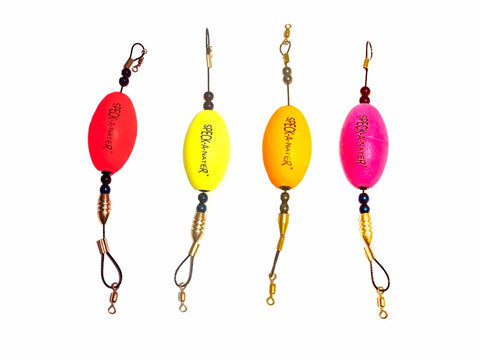
Oval Popping Corks Perfect For Inshore Fishing
The most popular style of popping cork is the egg cork or oval cork. When inshore fishing for redfish or trout the oval popping cork is perfect for making a loud popping noise mimicking fleeing shrimp. These loud noises are guaranteed to attract more fish to your baits. oval floats have a much bigger profile than the cigar corks making them a cork perfect for fishing in murky waters. On the market, you will find several different sizes and a bunch of different colors. This is often angler dependent depending on the type of fishing you are doing. The range of prices on these varies from the cheap cajun thunder popping cork to the mid-range Speck-a-nater popping cork all the way to the most expensive and overpriced 4 Horsemen 3" popper.
Style #2: Cupped Cork
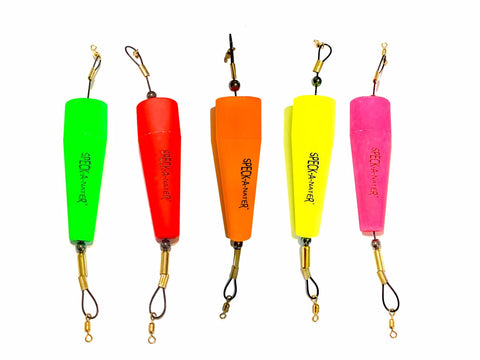
A Cupped Popping Cork Is Used To Catch Many Saltwater Species
One of the loudest corks on the market is the cupped cork. Their cupped topped creates a unique splashing noise that will attract fish. They are great for fishing in murky water. In cloudy and murky water fish rely on their senses so the sound they produce only helps enhance this for the fish. They have a slimmer profile than the oval corks so they are a lot easier to cast in windy conditions. Like most other popping corks they come in a variety of sizes and colors.
Style #3: Pear Popping Cork
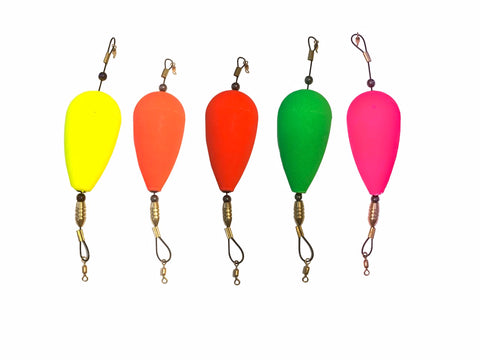
A Pear Popping Cork Can Be Used For Large Tarpon
The largest popping cork on the market is the pear cork. These are the ultimate floats for fishing for big fish. Big baits need big corks. Several species anglers will target with these corks are redfish and tarpon. Like their smaller cousin the oval floats, they make a great amount of noise in the water. On windy days they will be hard to cast with precision, but you will be able to cast them a mile. They come in different colors that will be perfect for fishing in different waters.
Style #4: Weighted /Unweighted Cork
When it comes to popping corks, one thing that is important is the distance it can be cast. This is determined by the aerodynamics of the corks make and the current wind conditions. Weighted corks are perfect for long-distance casting. This extra weight at the bottom makes them perfect for casting while inshore fishing and allows for them to float upright while in the water. Some anglers prefer the opposite which is unweighted corks. These can be floated in currents and work because they remain on their side and only become upright when the lure or bait is pulling down. This allows for your bait to settle before the cork popping occurs.
Style #5: Cigar Cork
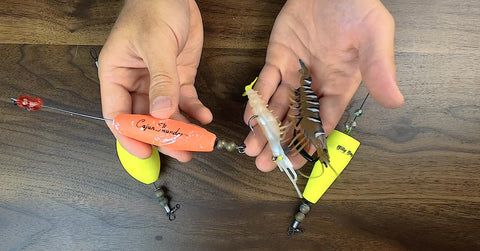
Cigar Cajun Thunder Popping Cork
Cigar corks are the long skinny style of cork that resembles a cigar. These corks are available on the market in a variety of sizes. The majority can be found in the 3’ style that is perfect for casting and fishing in windy conditions. They are best used in clean water conditions because the floats take up a smaller profile on the top of the water. When water conditions are clear the fish tend to be more scared of things on top of the water. Using larger corks will spook the fish and it will be a lot harder to catch anything after a cast due to a large splash that is generated. Their low profile makes them narrow and increases their ability to fly through the air in windy conditions. One rule I like to keep, “When the wind blows you throw cigars.”
Style #6: Slitted Cork
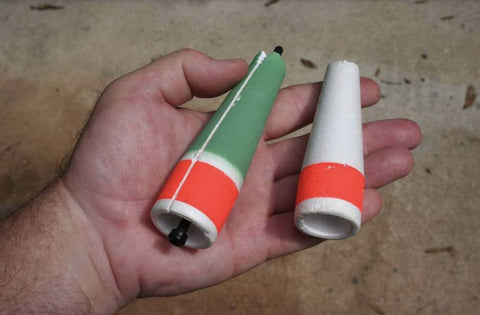
The Original Slitted Cork For Easy Addition and Removal From Line
One of the disadvantages of many popping corks is the depths at which they can be fished. Your leader line on the backside is precut to whatever depths you want to fish. When you change depths on the fly you must cut and retie your floats. The slitted corks are perfect for combating this problem. By having slits or clips attached to your leader line you can easily adjust the depth at where you would like to fish. The slitted floats make it easy to adjust your depths on the fly when it changes while saltwater fishing.
Why Popping Corks Work & How To Fish Them
Popping corks are constructed with some of the best materials on the market. Many come with titanium wires that will always bounce back into place no matter how much they are bent. They feature the best beads that are perfect for generating noise for attracting fish. Many of the floats are feature inserts that aid with the beads to generate more sounds and vibrations. This also keeps the popping cork better preserved on the wire.
No matter what brand, shape or style of popping cork you like to fish, there is something for everyone. Popping corks should be in every anglers tackle box and used on a regular basis. Connecting your popping cork to a leader line at the desired depth you wish to fish. The weights on the cork will allow you to cast your float rigs at longer distances to cover more water while fishing. The lure or bait that is attached will then float down below the cork float. Simply pop the cork several times pulling it through the water and allow the bait to sink again. Do this over and over until you catch fish. Sometimes when the fish aren’t biting, using a popping cork can generate enough sounds and vibrations to trigger a reaction bite.
Fishing Live Bait With Popping Corks
Using live bait with a popping cork is perfect for catching fish inshore. The majority of baits can be fished under a float, but anglers will choose to fish shrimp, crabs, and mullet the majority of the time. By placing your live bait under a cork it allows for you to create the noise and attention to get the fish active while free-floating your bait to entice a strike. This is a method that has caught fish time and time again while inshore fishing.
How To Fish With Live Shrimp Under A Popping Cork
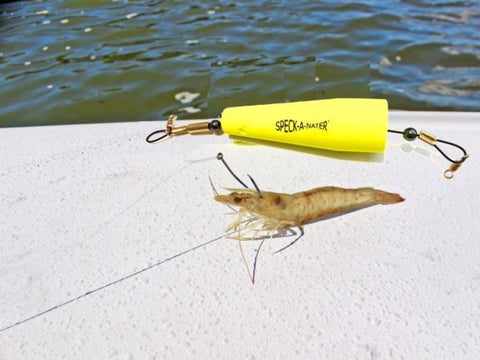
Fish With Live Shrimp Under A Popping Cork Rig
One of the best species to target with live shrimp under a popping cork rig is speckled trout. Trout feed on a diet of mullet and trout making them prime targets for striking your popping cork rigs. When you chose to use shrimp they can be rigged in several different ways. Many anglers will choose to hook shrimp through the tail or in the head. There are tons of other species like cobia, redfish, snook, and flounder that are known for hitting your bait under popping corks. Most inshore species love shrimp. The natural popping sound of shrimp is mimicked by these floats which are perfect for bringing a school of fish around.
How To Make A Popping Cork Rig
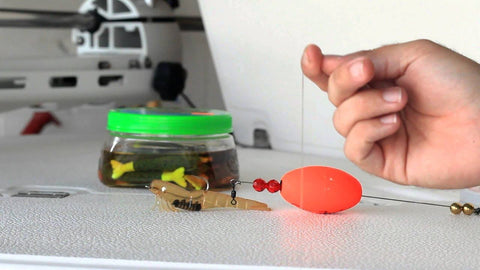
Best Way To Make A Popping Cork Rig For Artificial Baits
Many anglers will fish a popping cork rig with artificial bait. One company that comes to mind is DOA. They are known for their artificial shrimp and were one of the first to pair them with floats. Floating any type of artificial lure can result in fish. The floating and popping of the corks adds a lot of motion and movement too many lures giving them the desired appearance to result in bites. Maybe you are an inshore jig fisherman and love using jig heads. Putting jigs with gulp shrimp or paddle tails under it can be a great combination. The inshore slammer j-hook is a jig head made for catching fishing and bringing your soft plastic baits to life. Another great artificial lure that can be fished with a cork are spoons. Weedless spoons give the perfect movement when being popped behind a cork. There are many more combinations of artificial baits on a popping cork rig. Find one that works and fish it to fill a cooler with meat.
How To Fish A Popping Cork
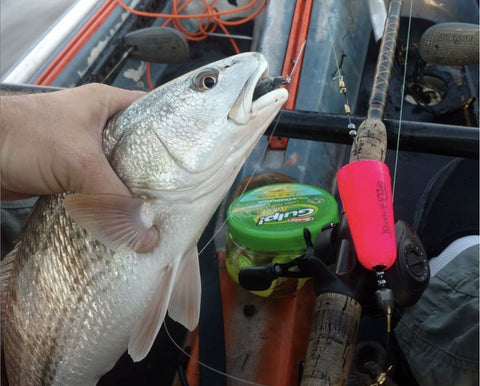
Knowing How To Fish A Popping Cork Will Catch More Fish
The are several companies out there that sell popping corks and claim theirs are the best. 4 horseman, bomber, red alert lures and Cajun Thunder popping corks are a few of these companies that specialize in fishing floats. The key is to find the best noise producing cork for the best price. There is no reason to break the bank on floats. There is a learning curve when learning to fish with popping corks. The more you fish with them, the better you will become resulting in more fish caught. You will learn to love them and make them your go to inshore fishing rig. They have caught us coolers of fish time and time again and we feel that every angler should be using popping corks.
If you have any questions, comments or concerns, please feel free to leave us a comment below or email us at [email protected]. We would love to hear your about your popping cork rigs and all your inshore fishing experiences. We would also love to see all of your inshore catches on corks so make sure you send us all your great fish to be featured on our social media pages. Don't forget to get stocked with our inshore jigs for your next fishing trip to pair with your corks. Get you some popping corks today and start popping for fish.


Leave a comment